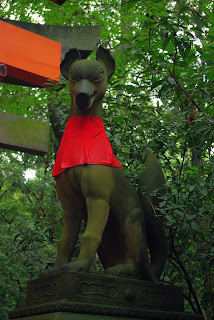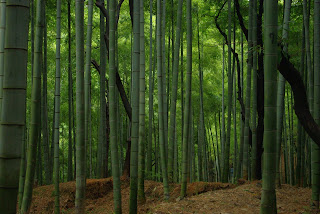I hauled my bags out again this morning, grabbed a bus from Gion to Kyoto Station, and hopped on the Shinkansen for the brief trip to Shin-Osaka Station. From there I had to navigate some more trains to get me to JR-Namba Station in Osaka. I accidentally ended up on a spur out of the central Osaka loop at one point, costing be about 25 minutes. The Yamanote loop line in Tokyo was so simple! Why is the Osaka loop all weird? Plus, all the Osaka stations have an intensely annoying jingle that is supposed to signal an approaching train, but I'm pretty sure it just plays constantly. Anyway, I made it to my hostel by 11:30am or so.
After spending a little time figuring out what to do, I decided a dreary day like today would be a good chance to visit one of the few Frank Lloyd Wright houses still standing in Japan. I grabbed a train headed for Kobe and got off at Ashiya.
After a short walk, I could see the house perched on the side of a hill. It was pretty cool to finally visit one of Wright's houses. I'd been to one or two of his larger buildings, but never one of the houses - likely the building type that he is most famous for. As I walked through the place, I noticed everything I'd seen in our architecture history textbooks: the attention to detail and "total design", the hidden entrance, small spaces opening into larger spaces, a unique motif that is repeated in different places throughout the building, the large overhangs. All that good Wright-y stuff was there. Here are a few pictures from the visit:


Afterwards, I decided to head down to the Osaka waterfront to take a look at Ando's Suntory Museum as well as try to get a look at an interesting underground stadium designed by Nikken Sekkei. The whole stadium is sunk into the ground and covered with a public park. As I left the Suntory Museum, though, it started to rain again, so I had to take pictures of the stadium out the window of my train. It wasn't a bad view, actually:


That evening, it was still a bit rainy, but I met a Korean guy at my hostel who felt like going out to try some local food. He was actually an architecture student as well, so we a little bit to talk about. We went to a place and tried two of the foods the Kansai region is famous for - okonomiyaki (grilled vegetable and meat pancakes made up of many different ingredients mixed together), and takoyaki (fried balls of flour with octopus inside). Both were excellent, I have to say. We tried hitting a bar or two afterwards, but the rain had driven many people away. Eventually we called it a night and headed back to the hostel, where there was actually much more going on than there was out at any bar! A group of about 8 or 9 travelers were downstairs in the lobby hanging out and having some beers bought at the convenient Lawson store next door. I ended up staying down there for a while before finally heading up to bed.





















































